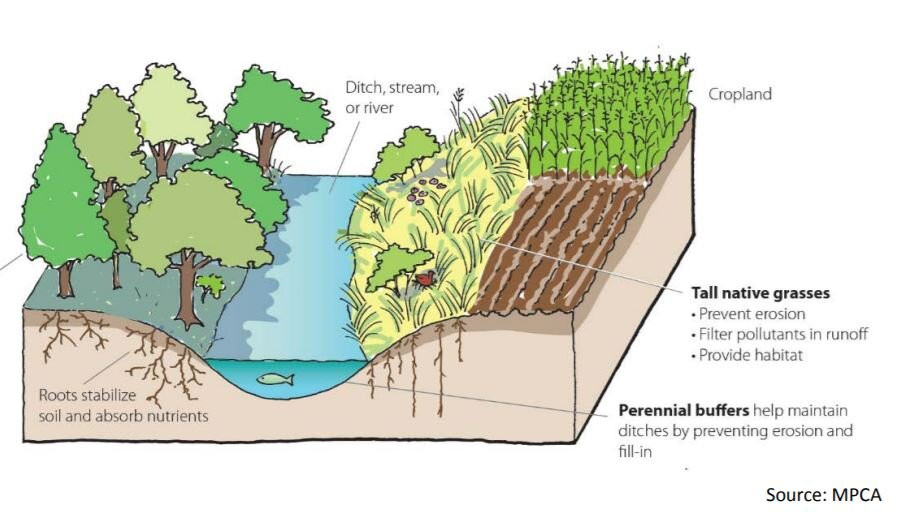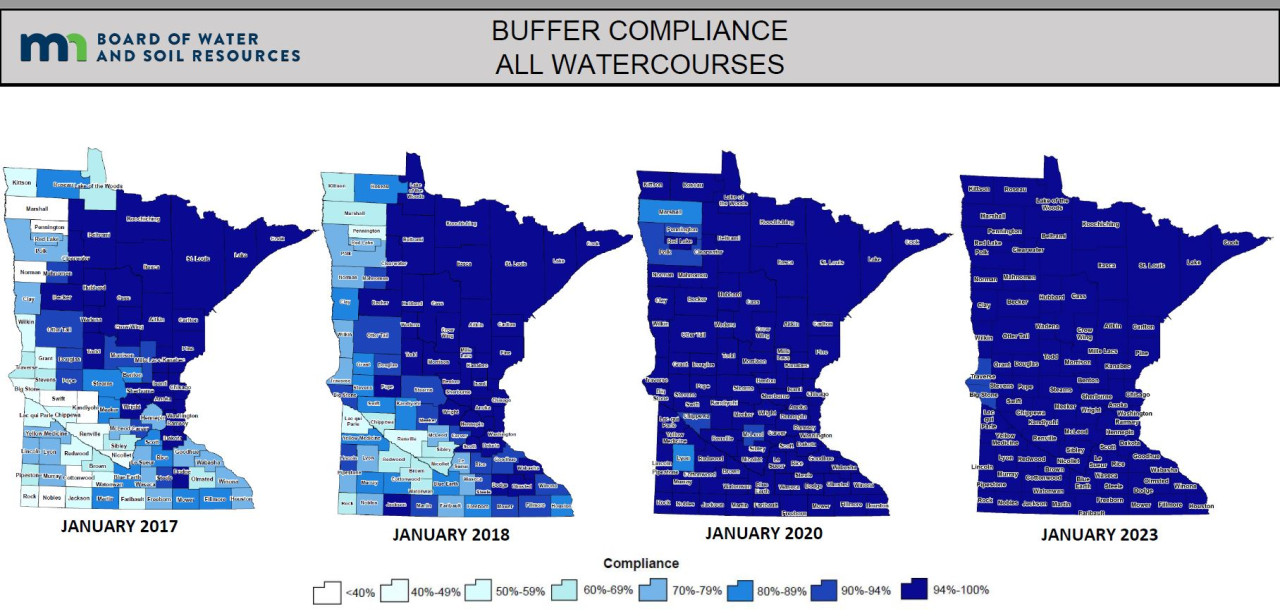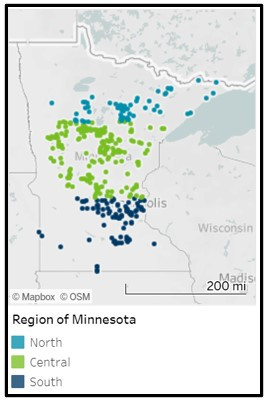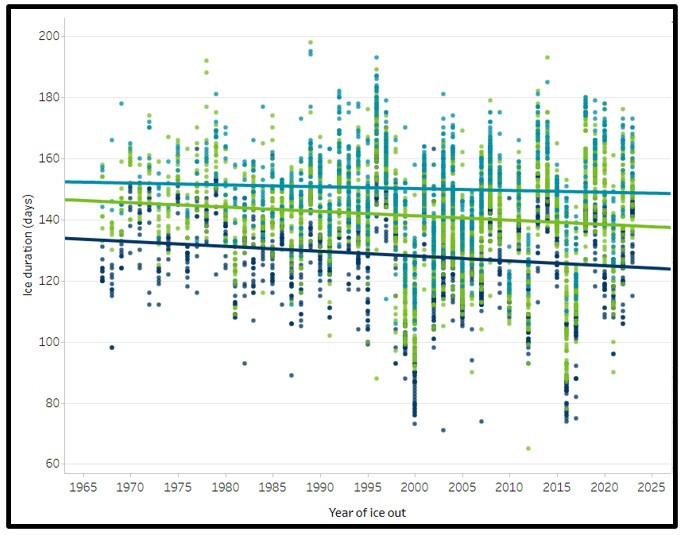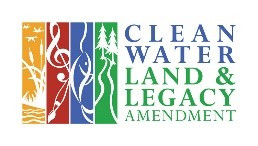Cedar tree revetments are a low cost, environmentally friendly option to address eroding streambanks. Cedar revetments use Eastern red cedar trees to serve as natural armor, providing protection along eroding riverbanks. Revetments will slow or stop erosion during the project's lifespan and reduce the likelihood of a much larger and more expensive corrective project in the future. Riverbank erosion contributes sediment and other pollutants into waterways, reduces riparian habitat, and results in property loss. Stabilizing your eroding riverbank will provide water quality benefits as well as protect your property.
Nearly a decade after Minnesota's buffer law was enacted in 2015, 99.8% of parcels adjacent to Minnesota waters are in compliance with the law. Buffers are also known as a riparian filter strip adjacent to a stream, river, lake, or wetland. These buffers filter out phosphorus, nitrogen, and sediment. Studies completed by the Minnesota Pollution Control Agency show that buffers are important for protecting and restoring water quality, natural stream functions, and aquatic habitat and life. Buffers are required along public waterways and ditches. Public waterways include lakes, rivers, and streams. This type of waterway requires a 50-foot average buffer. Buffers of 16.5 feet are required along public ditches.
ACD was proud to announce that Anoka County was 100% compliance back in fall, 2020. This milestone was achieved through strong partnerships between Anoka County, ACD, local landowners, and BWSR. This achievement doesn't mean that the hard work is over but it does represent a great success and displays the impact that strong environmental policy can have across the state of Minnesota. The next phase, includes another ACD review of properties throughout Anoka County to identify non-compliant parcels. This review began in Spring, 2024 and is based on recently released aerial photos. Compliance status and progress is tracked using the Buffer Compliance and Tracking Tool (BuffCAT), a state developed GIS database and mapping system.
Transfers in property ownership and land management changes, will require ongoing efforts by ACD in order to maintain existing compliance and to bring other parcels into compliance. Many landowners with noncompliant parcels have plans in place to seed the sites, or to implement an alternative conservation practice that provides comparable water-quality benefits this spring. Visit the ACD website to learn more about Buffer law implementation or contact Kris Larson, Water Resource Specialist, at
What is a Cedar Tree Revetment?
Cedar tree revetments use Eastern red cedar trees to serve as soft, natural armor, providing protection along eroding riverbanks. This protection decreases erosion and allows silt and sand to be deposited overtime. The deposited material forms a bed in which the seeds of riverbank plants such as sedges can grow. By the time the trees have decayed, the bank should be stabilized by the root systems of new plant growth and accumulated sediment. Revetments are ideal for riverbanks experiencing mild to moderate erosion. For riverbanks more than 5 ft. tall or areas with high water velocity, a revetment practice may be inadequate to properly address the issue.
Why Install a Cedar Tree Revetment?
Cedar tree revetments are a low cost, environmentally friendly option to address eroding streambanks. Revetments will slow or stop erosion during the project's lifespan and reduce the likelihood of a much larger and more expensive corrective project in the future. Riverbank erosion contributes sediment and other pollutants into waterways, reduces riparian habitat, and results in property loss. Stabilizing your eroding riverbank will provide water quality benefits to the Rum River as well as protect your property.
This program is being funded through a Conservation Partners Legacy grant and there is currently funding available to eligible properties. If you live along the Rum River in Anoka County and are interested in learning more about installing a cedar revetment on your property, contact Kris Larson, Water Resource Specialist, at
With the warmer winter so far in 2023/2024, this is a good time to revisit Minnesota data on historical duration of ice cover. MPCA has interactive graphs showing lake ice durations over many years on their Climate Change and Minnesota's Surface Waters page. Choose the "Lake ice durations" tab at the top. The graph below shows the overall trend of lake ice duration (in days) from 1967 to 2023, with the colors representing Minnesota lakes in the north, central and south portions of the state.
You can choose to evaluate trends in the each of the three regions of the state, or for many individual lakes, over a period of record of your choice. See more details on the following tabs of Minnesota Pollution Control Agency's Climate Change and Minnesota's Surface Waters page: Lake ice durations, Lake temperature, River flows & floods, Biological communities and FAQ.
Unused wells can serve as direct conduits for surface contaminants to reach our aquifers. ACD was awarded a grant in 2020 through the Clean Water Fund to help eligible landowners seal unused wells located within Anoka County. This program has been extended to run through 2024 in order to continue to to provide local residents assistance with sealing an unused well on their property!
A well is defined as "not in use," when the well is not functional, cannot readily pump water, or has not been operated on a regular basis. A "not in use" well has not been sealed by a licensed well contractor. A well that is "not in use" (i.e., "abandoned") must be repaired and put back into use, permanently sealed by a licensed well contractor, or the owner must obtain a maintenance permit. In many cases, placing an old well back into use is not practical. Sealing your well is also legally required when you go to sell your home. If your house was built before public water was available, the property may have one or more wells. Wells can be located either inside or outside a residence.
Indoors look for:
- Glass block or concrete patch in an exterior step.
- Wells are often housed in a small room in the basement, many times under exterior concrete steps.
- Pipe sticking up out of the floor in your basement, or a concrete patch in the floor where the well was located.
- Low spot or sunken area in the ground.
- Metal, wood, or concrete cover or manhole.
- Areas that stay wet can be caused by an unsealed flowing well.
- An old shed or well house, or an old pump.
- Dug wells typically appear as a ring anywhere from 1 foot or several feet in diameter, made of concrete, tile, bricks, or rocks.
- Pipes above, at, or below the surface may indicate a well.





